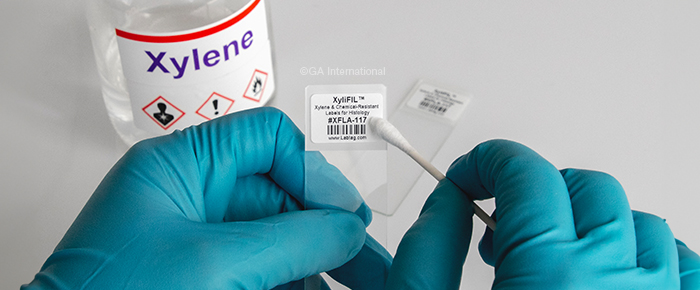
Once an identification system is designed, it’s important to test it beforehand to ensure that it works as intended, with as few errors as possible. With that in mind, several strategies can be implemented when testing your labels, which will ultimately provide smooth integration and efficient troubleshooting, helping eliminate mistakes in the long run.
Recreate a realistic workflow
The first step to testing labels is ensuring a workflow to test them with is in place. In the lab, this includes an experimental setup with containers, solutions, and equipment similar to the ones you will use throughout the labeling solution’s actual predetermined use. Though no one should be testing valuable experiment samples at this stage, it’s important to use sufficient quantities of buffers, alcohols, and any other chemicals the labels may contact. It’s recommended to use realistic exposure times for chemicals as well as any extreme temperatures, including for such conditions as steam autoclaving, heated water bath incubations, and cryogenic storage.
Remember, workflow isn’t exclusive to experimental conditions and sample processing. It’s essential to verify that all labels can be printed consistently and that they affix evenly and securely to each container. This is often where most troubleshooting occurs: setting up the printer, creating and using templates, and ensuring the finished product (i.e., barcodes and/or RFID) is printed and/or encoded accurately.
Scanners should also be tested throughout the workflow to ensure that barcodes and/or RFID are readable and that databases can be accessed and modified accordingly. This may require additional planning beforehand to determine the best way to scan each container. For barcodes, it is important to optimize how each container will be scanned using either handheld or stationary scanners. For RFID, though many samples can be read without the need for a direct line-of-sight, it is necessary to determine whether any interference, such as metal or aqueous barriers, may hinder the RFID chips’ readability. As with any RFID system, the optimal read range should also be tested.
Check the label and the printout
The printout is just as important as the label itself. Therefore, when testing any new identification system, don’t just make sure the label sticks to your containers; also ensure that there is no smudging or fading, which can affect barcode readability. This is best done by adjusting your printer settings according to the printout you wish to achieve. The darkness setting can usually be optimized to get a crisper printout, while it may be necessary to set the printer media setting to label or thick paper when printing on laser printers.
When harsh laboratory environments are required, a thermal-transfer printout is recommended. These printers, when utilizing resin ribbons, provide a printout that resists exposure to harsh chemicals, including alcohols, xylene, and other strong organic solvents that can easily smudge unprotected printouts. They also provide the best resistance against high heat from sterilization procedures and cryogenic storage in liquid nitrogen. The application of a lamination over the printout is also an option, as it offers added protection against chemical exposure and abrasion.
Consult your label manufacturer
It’s likely that, after rigorous testing, any new identification system will require some form of optimization. While it is tempting to perform optimization entirely in-house, it is recommended to consult with your trusted label manufacturer beforehand. By partnering with an experienced label supplier, any deficiencies experienced during the testing period can be assessed quickly and directly, with a tailored solution provided to ensure the system runs smoothly.
It’s also important to test the system in the long run once personnel have been trained and used it frequently enough to know that it works. If any problems arise weeks, months, or years down the road, contacting the label manufacturer can once again address these issues, potentially with newly developed, more efficient strategies that may not have been available before.
LabTAG by GA International is a leading manufacturer of high-performance specialty labels and a supplier of identification solutions used in research and medical labs as well as healthcare institutions.